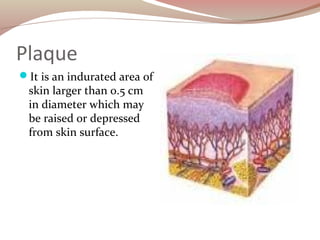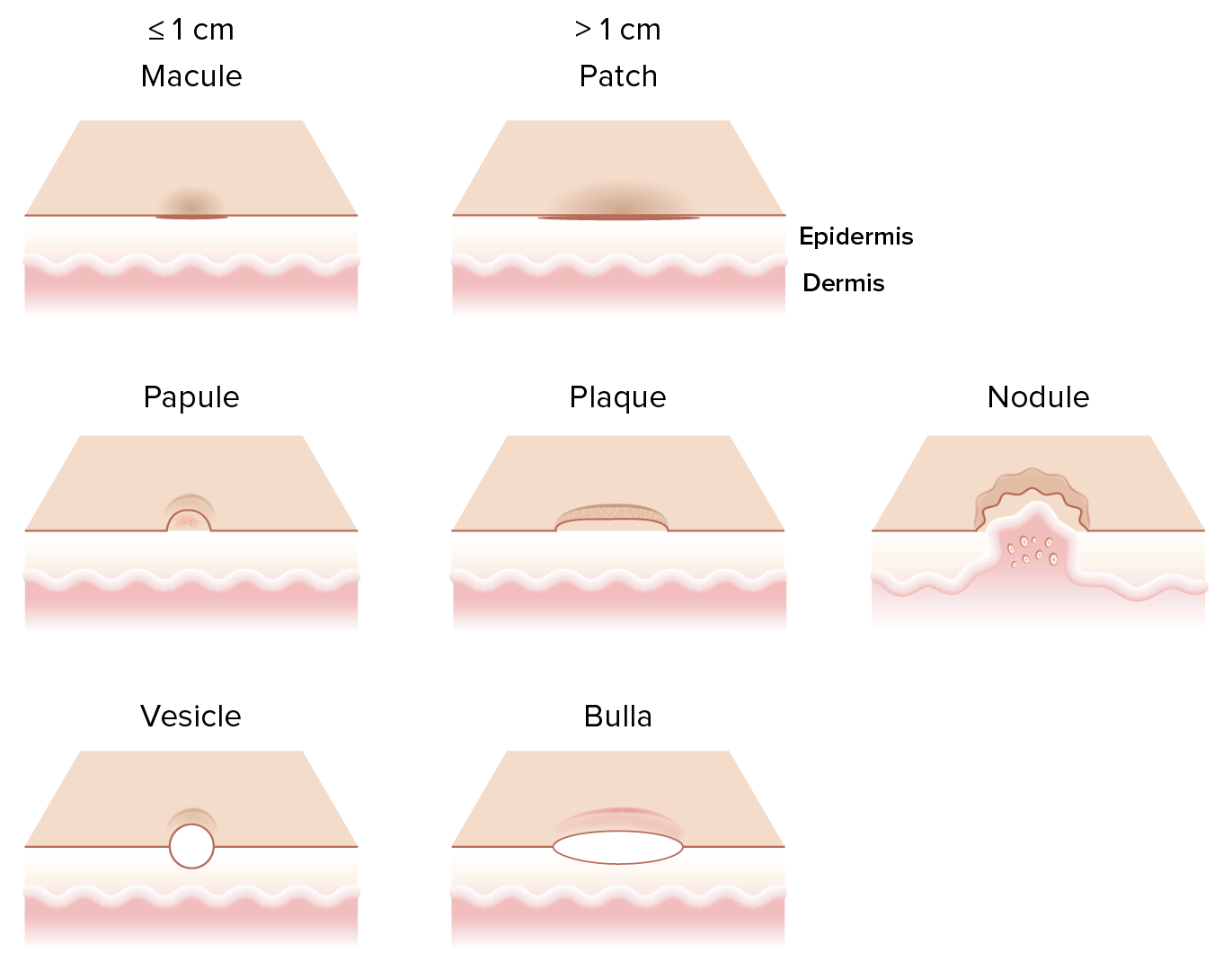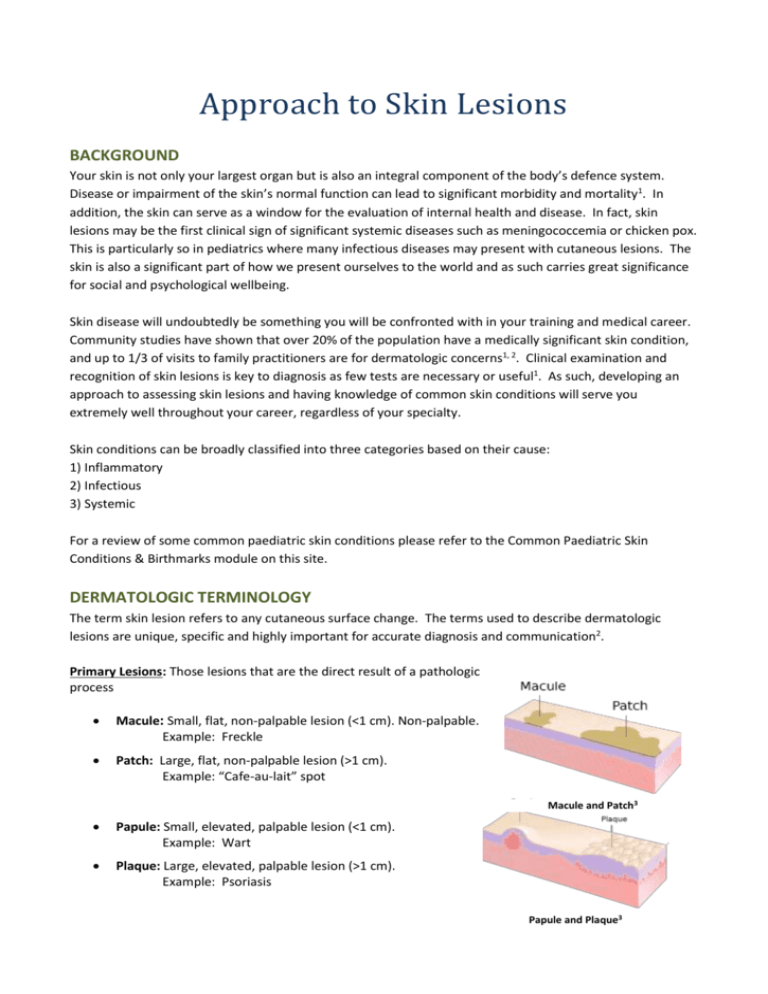Plaque - flat elevated lesion usually greater than 1 cm. Papules are associated with such conditions as warts syphilis psoriasis seborrheic and actinic keratoses lichen planus and skin cancer.
Plaque a circumscribed palpable lesion more than 1 cm in diameter.

. On Caucasian skin plaques typically appear as raised red patches covered with a silvery white buildup of dead skin cells or scale. Bulla - elevated fluid-filled lesion usually greater than 1 cm Size. Plaques may result from a coalescence of papules.
A skin lesion is a part of the skin that has an abnormal appearance compared to the skin around it. A malignant skin lesion is by definition skin cancer. Considering this what are the 3 types of lesions.
Nodule - elevated solid lesion greater than 1 cm. It is solid rough and flat-topped. Plaques are palpable lesions 10 mm in diameter that are elevated or depressed compared to the skin surface.
A macule can be a variety of colors based on the cause. The initial recognizable skin lesion or basic skin changes macule papule patch plaque vesicle bulla nodule tumor pustule wheal cyst telangiectasia. Commonly used to describe a portion of the rash of cutaneous candidiasis in which a beefy red plaque maybe found surrounded by numerous smaller red macules located adjacent to the body of the main lesions.
The most common form plaque psoriasis causes dry raised red skin patches lesions covered with silvery scales. Papules and plaques can be rough in texture and red pink or brown in color. It is solid rough and flat-topped.
Most plaques are elevated but a plaque can also be a thickened area without being visibly raised above the skin surface. A plaque is a palpable flat lesion usually greater than 1 cm diameter. A lesion that is raised like a papule and is greater than 1-2 centimeter 04 to 08 inch in size.
Each type of skin cancer has unique characteristics but general signs of skin cancer can include rapidly growing skin lesions changes in the color or size of a preexisting lesion or a scabbing sore that doesn. The two main types of skin cancer are keratinocyte carcinoma and melanoma. Most plaques are elevated.
Superficial solid elevated 05 cm color varies. On skin of color the plaques may appear darker and thicker and more of a purple or grayish color or darker brown. A skin lesion is a broad term that refers to any abnormality on your skin.
They usually appear on elbows knees lower back. Study with Flashcards again. Circular collection of free fluid 1 cm.
Dried serum or exudate on skin. Click to see full answer. A plaque is a circumscribed palpable lesion more than 1 cm in diameter.
They usually show up on your elbows knees scalp. A fluid-filled blister less than 05 centimeter 02 inch in size. Study w definition first Quizlet does not allow the term to be a.
Lesions of psoriasis Psoriasis Psoriasis is an inflammatory disease that manifests most commonly as well-circumscribed erythematous papules and plaques covered with silvery scales. Edematous transitory plaque m ay last few hours. A sharply defined zone of demyelination.
At first the doctor thought John might have eczema. Lesions appear raised above the normal skin. Define plaque as used to describe a skin lesion.
Discover 21 types of skin lesions like acne and eczema. The numerous descriptive terms used in dermatology can be overwhelming and at times confusing as there are some variations in the use and meaning of these words in the literature. Vesicle - elevated fluid-filled lesion usually less than 1 cm Pustule - elevated pus-filled lesion usually less than 1 cm.
Identification and classification of a patients skin lesions are important steps in the diagnosis of any skin disorder. Consists of flakes or plates of compacted desquamated. Plaques may be flat topped or rounded.
Plaques are raised red patches covered with a whitish buildup of dead skins cells called scale. They may have well-defined or ill-defined borders. Skin lesions with some pictures.
Ad See What Results Can Look Like. Plaques may result from a coalescence of papules. An area of clearing in a flat confluent growth of bacteria or tissue cells such as that caused by the lytic action.
The plaques of psoriasis in plaque type are erythematous lesions with distinguishable borders and thick silvery scaling. If the lesion such as a dark spot on the skin isnt raised and its less than 1 cm in size its by definition a macule. A flat topped elevated area of the skin larger than 5-10mm may be formed from coalescence of papules psoriasis seborrheic keratosis Primary skin lesions.
Papule - elevated solid lesion less than 1 cm. Psoriasis plaques appear as raised inflamed and scaly patches of skin that may also be itchy and painful. And so we have covered all.
Superficial elevated solid flat topped lesion 1 cm. The plaques might be itchy or tender and there may be few or many. A Treatment Option That May Help You See Clearer Skin That Can Last.
A patch or small differentiated area on a body surface for example skin mucosa or arterial endothelium or on the. Most plaques are elevated but a plaque can also be a thickened area without being visibly raised above the skin surface. 1 However a few simple terms can be used to describe the cutaneous findings in.
A skin lesion can be a result of a simple scrape or. A skin lesion can be a rash mole wart cyst blister bump discoloration or other change that you may notice on your skin. Medical dictionaries define skin lesion as a superficial growth or patch of the skin that does not resemble the area surrounding it.
Plaques may be flat topped or rounded. Most plaques are elevated but a plaque can also be a thickened area without being visibly raised above the skin surface. A patch of closely grouped papules more than 25 in 1 cm across is called a plaque.
Most plaques are elevated.

Primary Skin Lesions Concise Medical Knowledge

Skin Lesions What Are They Types Causes Diagnosis Treatment And More Osmosis

0 Comments